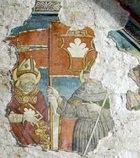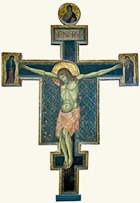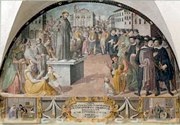

The Pinacoteca Civica is housed on the piano nobile of Palazzo Consoli.
[The stairs lead to what is now Room IV. Rooms I-III are straight ahead while Room V is behind you.]
Cappella Palatina
Madonna and Child with saints (ca. 1340)

Madonna and Child (14th century)
This detached fresco came from the Monastero di San Benedetto.
Sala dell’ Arengo
Madonna and Child with saints (14th century)

This fresco in situ at the foot of the stairs that lead to the Sala d’ Arengo the might have been part of Guiduccio Palmerucci’s decorative campaign of 1342. It depicts the Madonna and Child enthroned with SS John the Baptist and Ubaldus.
SS Ubaldus and Augustine (ca. 1503)

[An altarpiece by Orlando Merlini has recently been returned to the public gallery]
Room I
Madonna and Child with saints (13th century)
This polyptych, which depicts the Madonna and Child with SS Andrew, Bartholomew and Stephen, a deacon saint and two bishop saints, is sometimes attributed to the Maestro di San Francesco al Prato. It is of unknown provenance.
Christus Patiens (ca. 1300)

Madonna and Child (14th century)
This small tondo, which is attributed to Mello da Gubbio or Guiduccio Palmerucci, is of unknown provenance.
Madonna and Child with saints (14th century)
This small triptych depicts the Madonna and Child with SS John the Baptist and Antony Abbot. [Provenance ?]
Polyptych (ca. 1335)

This polyptych, which came from the Cappella Palatina (above), depicts the Madonna and Child with SS Marianus, Ubaldus, John the Baptist and James. The work is traditionally attributed to Guiduccio Palmerucci.

Three of its predella panels are in the Musée des Beaux Arts, Nancy, with an attribution to Mello da Gubbio. They depict the Crucifixion and two scenes of the martyrdom of SS Marianus and James.
Room II
Pietà (14th century)
This expressive terracotta sculpture by a German master is of unknown provenance.
Madonna and Child with angels (early 14th century)
This altarpiece, which has been damaged by fire, came from Santa Maria dei Laici.
Frescoes (14th century)
These three detached frescoes were removed from Santa Maria Nuova in 1910. They depict:
-
✴the Madonna and Child enthroned;
-
✴the standing Madonna and Child; and
-
✴St John the Baptist.
Tabernacle (14th century)
This tabernacle was discovered in the sacristy of San Francesco in 1910. It was originally probably used for the personal devotions of one of the friars. It is decorated with small works of art of various provenances, together with four small gilded glass reliquaries.
Room III
Christus Patiens (early 14th century)
This painted Crucifix, which is of unknown provenance, is somewhat tentatively attributed to the Maestro Espressionista di Santa Chiara (Palmerino di Guido?).
Virgin with SS Augustine and Monica (15th century)
This altarpiece depicts the Virgin, who stands on Christ’s sepulchre, with SS John the Baptist and Ubaldus. It is documented in the sacristy of Sant’ Agostino and probably came from the Cappella di Santa Maria Assunta there.
Room IV
Gonfalon of St Ubaldus (1503)

The Commune commissioned this double-sided processional banner, which is signed by Sinibaldo Ibi and dated by inscription.
-
✴One side depicts the standing St Ubaldus in episcopal robes, his right hand raised in blessing, and two angels, one of which holds his episcopal staff.
-
✴The other side depicts the Madonna della Misericordia with musical angels and two groups of worshippers (one male and one female) kneel below. Two of the angels above the Madonna hold a crown above her head.
The Commune entrusted the banner to the nuns of Santo Spirito, and it was carried in procession in times of need. On the feast days, the Confraternita dei Bianchi carried it in procession from Santo Spirito to the Duomo, where it stayed on the high altar for the octave of the feast. Controversy broke out in 1663, when the nuns unilaterally removed it from the Duomo on the feast of Corpus Cristi and installed it outside their nunnery. The Commune, at the behest of Bishop Alessandro Sperelli, ordered its return to the Duomo and insisted that it should be kept in the chapel of Palazzo dei Consoli thereafter. Cardinal Carlo Bichi, the vice-legate of the Romagna, mediated and arranged for the return to the status quo after the nuns had shown appropriate contrition.
The banner was restored in 1742 (by Giuseppe Reposati), in 1780 and in 1832. It was enclosed in the present gilded wooden frame in 1833 and transferred “permanently” to the Duomo, although it continued to be used in processions. It was restored again and transferred to the Pinacoteca in 1900.
Immaculate Conception (1527)
This large altarpiece is of unknown provenance. It is by/attributed to Francesco Signorelli, who was the nephew and pupil of Luca Signorelli.
Discovery of the True Cross (1562)
This altarpiece came from Santa Croce del Mercato. The inscription records the artist, Benedetto Nucci and the name of the Camaldolesian monk who commissioned it, Francesco Gaugello. The date was assigned the date by a local historian in the 19th century. The altarpiece depicts St Helen finding the remains of the True Cross in Jerusalem.
Pentecost (1563)

Resurrection of Lazarus (1586)
This large altarpiece, which is of unknown provenance, is by/attributed to Virgilio Nucci.
Burial of Christ (16th century)
This altarpiece, which is attributed to Benedetto Nucci, is a copy of an altarpiece in SS Trinità that is signed by this artist and dated by inscription to 1562.
Altarpiece (16th century)
This composite altarpiece came from SS Trinità. The “Noli me tangere” is depicted above, and SS Francis and Clare flank a tabernacle below.
Gonfalone dei Calzolari (1649-50)

The banner is painted in oil on canvas and has a silk surround. It depicts the Virgin holding the dead body of Christ, with St Crispin (the patron of the guild) and St Ubaldus to the sides and God the Father above.
Franciscan altarpiece (early 17th century)

The altarpiece depicts St Francis kneeling beside the docile wolf in what is probably an idealised representation of Piazza Grande. He seems to be preaching to the crowd about the scene above, in which Christ in Judgment is flanked by the Virgin (with a halo of stars that symbolises her Immaculate Conception) and SS John the Baptist and Ubaldus. The stigmata in his right hand and his cord (representing poverty) are prominent. He holds similar cords in his left hand that he presumably intends for those members of his audience who are moved to join the Compagnia del Cordone. A number of Franciscan saints attend the sermon:
-
✴SS Antony of Padua, Bonaventure, Louis of Toulouse, Bernardino of Siena and Louis of France, to the left of the podium; and
-
✴SS Clare and Elizabeth of Hungary with two other Franciscan women below it.
Room V (Sala dell' Udienza)
Portrait frescoes
These frescoes of Guidobaldo II della Rovere (1572) and Francesco Maria II della Rovere (1602) are in situ on the back wall. A third, of Francesco Maria’s son, has been lost. The frescoes are by/attributed to Virgilio Nucci.
St Francis and the Wolf of Gubbio (1612)

This fresco of St Francis and the wolf in Piazza Grande, which is dated by inscription, is in situ on the entrance wall. It is attributed to Federico Brunori. It shows St Francis with the pacified wolf preaching in front of Palazzo dei Consoli. The scenes to the sides of the inscription depict two episodes relating to the provision of a new habit by Federico Spadalonga:
-
✴the purchase of the fabric; and
-
✴the manufacture of the habit.
Tree of Jesse (1570)
Sister Settimia degli Accoromboni of the Monastero di San Benedetto commissioned this altarpiece, which is attributed to Benedetto Nucci. [Dated by inscription ?]
Flight into Egypt (1634)

St Crescentian (early 17th century)
This altarpiece is of unknown provenance. It is attributed to Simon Vouet (1590-1649) and was presumably painted during the French artist’s stay in Rome in 1613-27, where he became a follower of Caravaggio.
Vision of St Andrew (1688)
This altarpiece, which depicts the Virgin appearing to St Andrew, is signed by Antonio Gherardi and dated by inscription. Its original location is unknown.
Madonna and Child (17th century)
This altarpiece is of unknown provenance. [By/attributed to Giovanni Battista Salvi, il Sassoferrato (1601-85)]
Deposit
Universal Judgement (1569)
This altarpiece, which is signed by Virgilio Nucci and dated by inscription, is the earliest securely dated work by this artist. It came from the Duomo.
Immaculate Conception (1584)
This altarpiece from San Francesco is attributed to Virgilio Nucci.
Pala Tondi (1610)
The inscription of this altarpiece records: the artist, Virgilio Nucci; the date, 1610; and the name of the commissioner, Francesco Tondi. The altarpiece, which probably came from the Monastero di San Benedetto, depicts the Madonna and Child enthroned with SS Sebastian, Ubaldus, Francis and Catherine of Alexandria.
St Frances of Rome (1611)
This altarpiece, which is signed by Virgilio Nucci and dated by inscription, was removed in ca. 1930 from the Cappella di Santa Francesca Romana (later the Cappella del Rosario) in San Pietro. It depicts St Frances of Rome, who had been canonised in 1608. (The signed panel (1613) in the lunette above, which depicts the Annunciation, remains in situ.)

